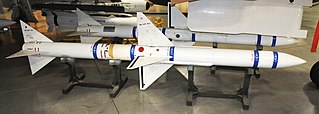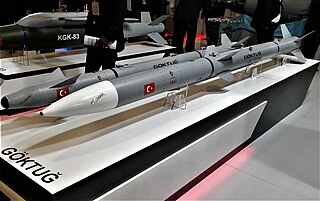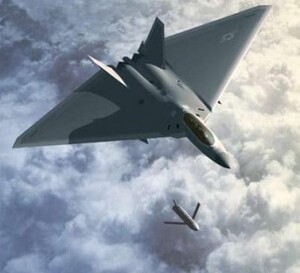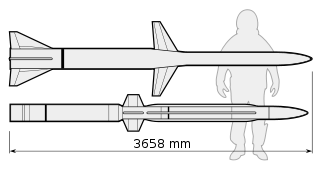Related Research Articles

The AIM-7 Sparrow is an American medium-range semi-active radar homing air-to-air missile operated by the United States Air Force, United States Navy, United States Marine Corps, and various other air forces and navies. Sparrow and its derivatives were the West's principal beyond visual range (BVR) air-to-air missile from the late 1950s until the 1990s. It remains in service, although it is being phased out in aviation applications in favor of the more advanced AIM-120 AMRAAM.

The AIM-120 Advanced Medium-Range Air-to-Air Missile(AMRAAM) ( AM-ram) is an American beyond-visual-range air-to-air missile capable of all-weather day-and-night operations. It uses active transmit-receive radar guidance instead of semi-active receive-only radar guidance. When an AMRAAM missile is launched, NATO pilots use the brevity code "Fox Three".

The AIM-54 Phoenix is an American active radar-guided, beyond-visual-range air-to-air missile (AAM), carried in clusters of up to six missiles on the Grumman F-14 Tomcat, its only operational launch platform.

The Advanced Short Range Air-to-Air Missile (ASRAAM), also known by its United States designation AIM-132, is an imaging infrared homing air-to-air missile, produced by MBDA UK, that is designed for close-range combat. It is in service in the Royal Air Force (RAF), replacing the AIM-9 Sidewinder. The ASRAAM is designed to allow the pilot to fire and then turn away before the opposing aircraft can close for a shot. It flies at over Mach 3 to ranges in excess of 25 kilometres (16 mi). It retains a 50 g maneuverability provided by body lift and tail control.

An air-to-air missile (AAM) is a missile fired from an aircraft for the purpose of destroying another aircraft. AAMs are typically powered by one or more rocket motors, usually solid fueled but sometimes liquid fueled. Ramjet engines, as used on the Meteor, are emerging as propulsion that will enable future medium- to long-range missiles to maintain higher average speed across their engagement envelope.

The Lockheed Martin FB-22 was a proposed supersonic stealth bomber aircraft for the United States Air Force, derived from the F-22 Raptor air superiority fighter. Lockheed Martin proposed its design in the early 2000s with support from certain Air Force leaders as an interim "regional bomber" to complement the aging U.S. strategic bomber fleet, whose replacement was planned to enter service after 2037. The FB-22 was to leverage much of the design work and components from the F-22 to reduce development costs.

The Hughes AIM-4 Falcon was the first operational guided air-to-air missile of the United States Air Force. Development began in 1946; the weapon was first tested in 1949. The missile entered service with the USAF in 1956.
A beyond-visual-range missile is an air-to-air missile that is capable of engaging at ranges around 40 km (22 nmi) or beyond. This range has been achieved using dual pulse rocket motors or booster rocket motor and ramjet sustainer motor. Medium-range, long-range, and very-long-range air-to-air missiles fall under the category of beyond-visual-range missiles. Older BVR missiles generally used the semi-active radar homing, and modern BVR missiles use the active radar homing guidance.

The AGM-86 ALCM is an American subsonic air-launched cruise missile (ALCM) built by Boeing and operated by the United States Air Force. This missile was developed to increase the effectiveness and survivability of the Boeing B-52G and B-52H Stratofortress strategic bombers, allowing the aircraft to deliver its payload from a great distance. The missile dilutes an enemy's forces ability to respond and complicates air defense of its territory.

The Vympel R-37 is a Russian hypersonic air-to-air missile with very long range. The missile and its variants also had the names K-37, izdeliye 610 and RVV-BD, and the NATO codenames "Axehead" and "Andi". It was developed from the R-33.

The PL-12 is an active radar-guided beyond-visual-range air-to-air missile developed by the People's Republic of China. It is considered comparable to the US AIM-120 AMRAAM and the Russian R-77.

The AIM-152 Advanced Air-to-Air Missile (AAAM) was a long-range air-to-air missile developed by the United States. The AIM-152 was intended to serve as the successor to the AIM-54 Phoenix. The program went through a protracted development stage but was never adopted by the United States Navy, due to the ending of the Cold War and the reduction in threat of its perceived primary target, Soviet supersonic bombers. Development was cancelled in 1992.

The AGM-158 Joint Air-to-Surface Standoff Missile is a low detection standoff air-launched cruise missile developed by Lockheed Martin for the United States Armed Forces. It is a large, stealthy long-range weapon with a 1,000-pound (450 kg) armor piercing warhead. It completed testing and entered service with the U.S. Air Force in 2009, and has entered foreign service in Australia, Finland, and Poland as of 2014. An extended range version of the missile, the AGM-158B JASSM-ER, entered service in 2014 as well as an anti-ship derivative, the AGM-158C LRASM in 2018. By September 2016, Lockheed Martin had delivered 2,000 total JASSMs comprising both variants to the USAF. In August 2024 the US was reportedly considering supplying JASSM missiles to Ukraine.
The Mitsubishi AAM-4 is a medium-range active radar homing air-to-air missile. It is a modern beyond-visual-range missile developed in Japan and intended to replace the semi-active radar homing AIM-7 Sparrow missile in service. It has been operational since 1999. The main contractor is Mitsubishi Electric. The 2010 AAM-4B was the world's first air-to-air missile with an AESA radar seeker.

The GBU-53/B StormBreaker, previously known as the Small Diameter Bomb II, is an American air-launched, precision-guided glide bomb.
The Next Generation Missile (NGM), formerly the Joint Dual Role Air Dominance Missile (JDRADM), was a proposed Beyond-visual-range (BVR) air-to-air missile (AAM) capable of all-weather day and night performance, to replace the AIM-120 AMRAAM and AGM-88 HARM. It was proposed to be cancelled in the Obama Administration's 2013 budget request. A parallel project, the T-3 program has continued. The T-3 missile is aimed at three major targets — enemy aircraft, cruise missiles and air defence networks.

The SOM is a next-generation autonomous, stealth, high precision air-launched cruise missile developed by TÜBİTAK SAGE, Defence Research and Development Institute of Turkey. It was first revealed during the 100th anniversary celebrations of the Turkish Air Force at the Çiğli Air Base in İzmir, on 4 June 2011. Developed since 2006, the SOM is Turkey's first domestic guided missile for striking both stationary and moving targets at a stand-off distance of over 180 kilometers. Although being developed by TÜBİTAK SAGE which still holds authority over the design of the missile, ROKETSAN has been given the role of manufacturing and marketing the missile for export.

The PL-15 is an active radar-guided long-range air-to-air missile developed by the People's Republic of China.
The Long-Range Engagement Weapon (LREW) is a US Air Force concept for a next-generation beyond visual range air-to-air missile. Concept images shows a large, two-stage missile launched from an internal weapons bay of an F-22 Raptor. There have been some reports that the LREW is too big to fit in the F-22 or F-35 internal weapons bay and is suited for the F-15EX Eagle II or B-21 Raider. It is currently being developed by Raytheon. This program is separate from Raytheon's own AIM-174 very long-range air-to-air missile as well as from the AIM-260 JATM, developed by Lockheed Martin.
The AIM-260 Joint Advanced Tactical Missile (JATM) is an American beyond-visual-range air-to-air missile (BVRAAM) under development by Lockheed Martin. Designed to address advanced threats, the missile is expected to replace or supplement the AIM-120 AMRAAM currently in US service. The United States Department of Defense (DoD) considers the AIM-260A JATM program to be the number one air-delivered weapon priority for both the U.S. Air Force (USAF) and the Navy (USN); and its acquisition out-prioritizes other weapon system improvements and modernization efforts on any fielded aircraft. As of May 2024, the House Armed Services Committee was investigating whether more late-variant AMRAAMs would be required in light of the AIM-260 JATM not having entered full-scale production, despite the USAF having previously stated in May 2023 that AIM-260 development and production was on-schedule. In September 2024, Raytheon, the AIM-120 AMRAAM developer, stated that the newest AMRAAM variant, the AIM-120D-3, had reached the "threshold range" of the AIM-260. Raytheon also stated that new AMRAAM variants would be "complementary" to the AIM-260, with the AMRAAM acting as the "capacity weapon" and "affordable" weapon, while the JATM would "address the advanced threat(s)."
References
- ↑ "Fifth-Generation Weapons". Air & Space Forces Magazine. Retrieved 2023-04-26.
- ↑ Cenciotti, David (2012-11-30). "New (still quite secret) Hit-to-Kill missile for the F-35 unveiled: the Lockheed Martin "Cuda"". The Aviationist. Retrieved 2023-04-26.
- ↑ "Fifth-Generation Weapons". Air & Space Forces Magazine. Retrieved 2023-04-26.